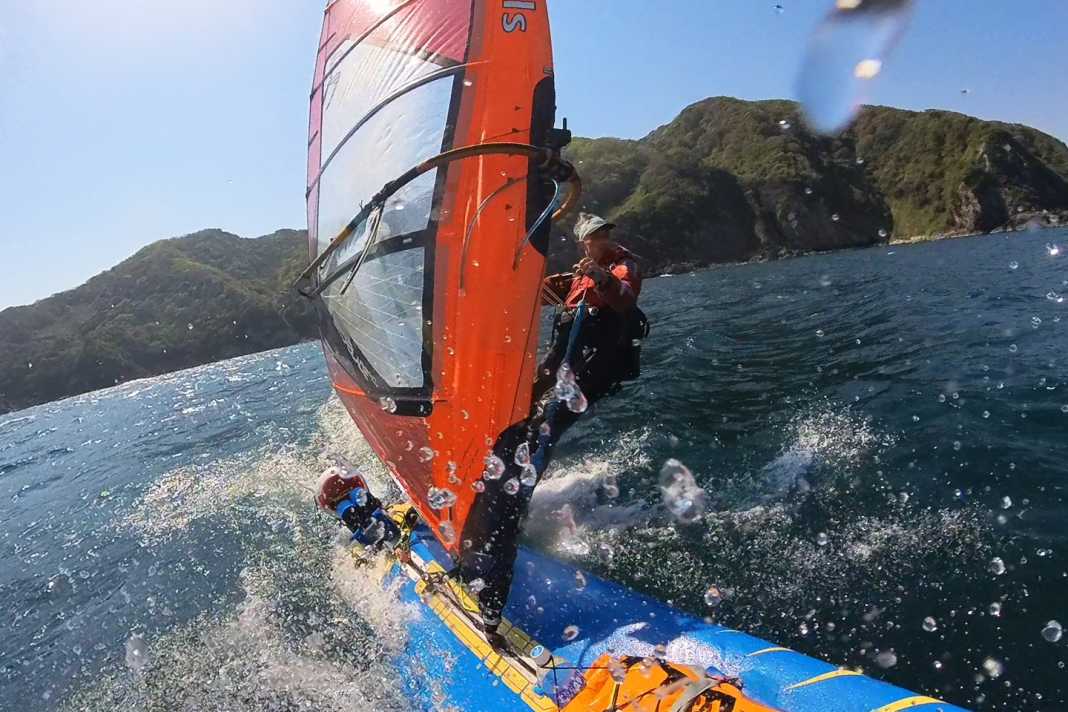





In September 2025, a few weeks after the end of his circumnavigation of Japan, we have an interview with Jono Dunnett. The appointment is postponed twice - the first time a promising wind forecast intervenes, the second time Jono is "unable to attend" because he is spending a night behind Swedish curtains. A few days later, he explains to us how all this relates to his windsurfing trip around Japan.
Jono, it's nice that we can finally talk. How are you?
Phew, it's an exciting time. I've recently returned from Japan and my friend Yumiko, who I met in Japan, has accompanied me to England. We went on a short bike tour along the coast. Yumiko had an unfortunate fall in front of a barrier, practically at zero speed. Maybe it was just bad luck, maybe she doesn't have the strongest bones - in any case, she broke her femoral neck. That was bad enough in itself. But because the fall was terribly unspectacular, the police asked questions afterwards about whether I might have had something to do with it. It was absurd but they didn't believe it was an accident and I actually had to spend a night in jail (laughs).
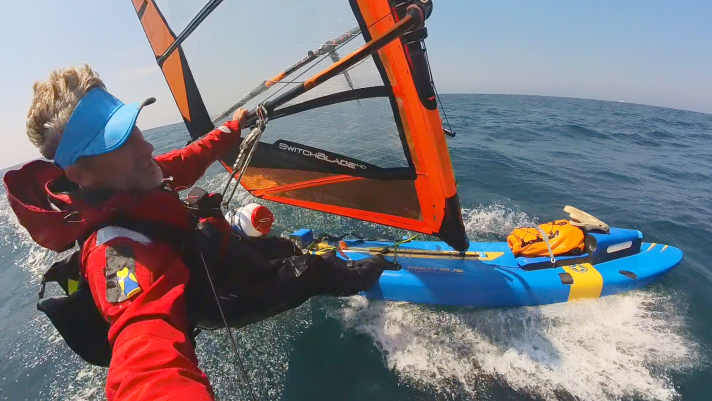
So your surfing trip indirectly landed you in prison...
(Laughs) In a way, yes. Fortunately, everything cleared up quickly, but of course it wasn't a pleasant experience. The most important thing is that Yumiko is slowly getting better.
Let's take a look back at your journey. A few years ago, you had surfed 15,000 kilometres around Europe. What attracted you to Japan?
I wrote a book about it after my circumnavigation of Europe (It's called "In the Balance", the ed.). At some point, a reader contacted me and said: "You would love Japan!" At the time, this fell on fertile ground, because I already had the idea of doing another big tour in the back of my mind - after all, I'm already over 50. Japan had already been on my mind a few years before, but I had dismissed it as too difficult. Now I started to look into it again. After a bit of research, my fears of a very difficult route were confirmed. But at least it would be safe on land.
What other countries are on your potential hit list?
Once around India! That would certainly have been fascinating too. But I was worried that I would have immediately fallen ill in the water there. Japan was much more relaxed in this respect. I also thought the distance was suitable in terms of length, because of course I didn't want to fly halfway around the world and after two weeks of surfing that was it. I also had a circumnavigation of the entire Baltic Sea in mind, but somehow everything just fell into place for the trip to Japan. I told a friend living in Japan about my thoughts and he was immediately super enthusiastic and offered to pick me up from the airport and help me with the organisation. That was the end of the story.
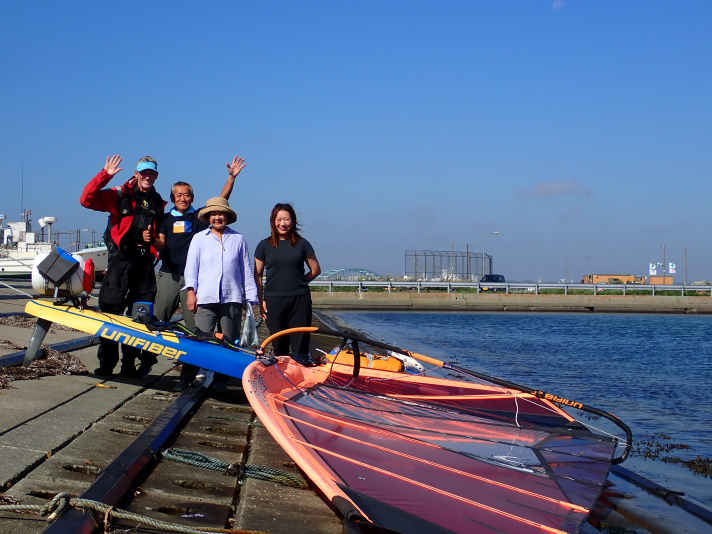
How long did the whole organisation take beforehand?
A few months already. If you've ever tried to register a 3.80 metre raceboard with the airline, you'll know what I mean (laughs).
Many windsurfing pros are currently struggling to get support from brands. How was it for you?
It was easier than I thought, probably because my circumnavigation of Europe some time ago was definitely noticed. Based on my experience, this time I wanted a race board that would be ideal in choppy, wavy conditions. At the Round Europe I used a raceboard from Starboard, which is great on a downwind course, but it hits the waves a bit on the upwind. The Unifiber race board, on the other hand, is smoother upwind and has more volume in the bow, which is good for transporting luggage in front of the base plate. I therefore enquired with Unifiber and - to my surprise - received an immediate confirmation, which was great.
On your first tour, you transported your luggage with a special carrier on the tail. Were you able to continue using your original design?
I used my old luggage barrel, I just had to adapt the mount for the board. I also modified the bow area of the board again so that it splits the waves better. With my Round Europe board, I sometimes had the problem that the bow dug in a lot when it entered the wave trough.
Japan is not Europe - how long did it take you to get into the groove?
It took me a long time to get used to it. Looking back, I can only shake my head at how terribly unprepared I was. I had no idea what to expect away from the water.
In what way?
When I arrived, I didn't even know how to pay in the many small grocery shops - in cash - or how to get my mobile phone working. My friend Paul had to get me on the right track in the first few days to make me viable (laughs). I was pretty stressed to finally start, because from the beginning I had it on my mind that my visa would expire after 90 days. I spent the first few days surfing with jet lag. Right on the second day, my luggage holder broke in the wind. I called Paul, he ordered carbon and resin and I surfed back to the starting point to repair everything. That took me a few days.
You started near Tokyo and then surfed the coast to the north-east. What were the biggest challenges on your route?
The east coast, where I started, is generally very exposed. This is the open Pacific and there is no natural protection, such as offshore islands. I therefore had to use the numerous harbours that exist here to land, as the area is heavily industrialised. However, the harbour facilities are mostly uninviting, not to say intimidating, because every harbour is surrounded by massive walls and piers due to the risk of tsunamis. The waves reflect off the sea defences, so it's chaos in front of the harbour. And once you've made it ashore, it's sometimes many kilometres to a small supermarket. And then you walk there and realise that it's already closed (laughs).
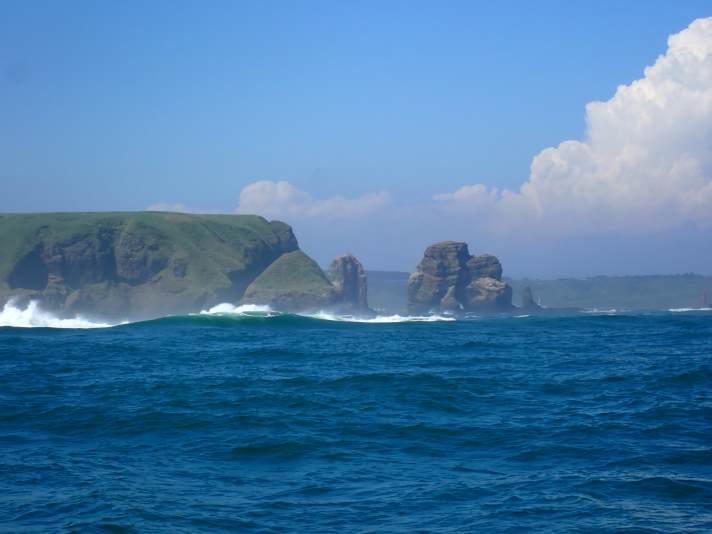
Looking back, I can only shake my head at how terribly unprepared I was.
So no romantic evenings under sail on lonely beaches...
No, unfortunately not. I wasn't keen on running into the coastguard straight away either, because I didn't know how my actions would be received here. My fear was that they wouldn't allow me to continue my journey for fear that I wouldn't have things under control.
How long did it take for them to get hold of you after all?
Luckily it took a while, I only had a few encounters with them once I had made the crossing to Hokkaido, the northern island of Japan. But in the end they were very nice and I realised that they just wanted me to get on safely. Their concern was probably that I would accidentally abort to Russia (laughs). Somehow I was even a bit glad that they now had me on their radar - it could have been helpful if the worst came to the worst.
How were you able to communicate with the local people at all?
That was actually quite difficult. I had assumed beforehand that English would be a bit more widely spoken than it actually is. That was probably the typical arrogance of an Englishman who thinks the whole world has to speak his language (laughs). Fortunately, things went reasonably well with the people from the coastguard. Apart from that, fortunately there are translation programmes on mobile phones these days that make communication easier.
Looking back, was the first part of the route, along the east coast, the most exciting part of the journey?
Each section had its own pitfalls. But the route around the northern island of Hokkaido was indeed special. The further north you go, the less industrialised the coast is. But then you have other problems on land - bears, for example.
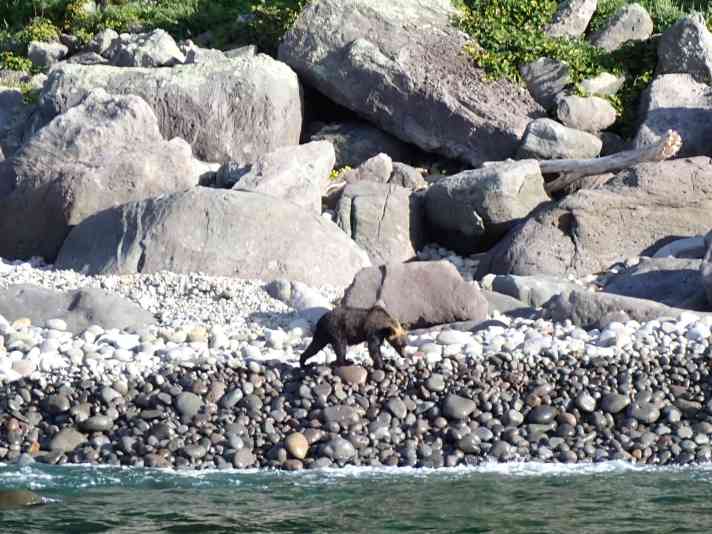
Were you prepared for that? Or was Master Petz suddenly standing in front of your tent in the morning?
I already had this on my mind, it was one of my biggest worries beforehand. Paul had given me bear spray right at the start. On the Shiratoko peninsula, I saw one from the water, running along the beach. But at some point I had to land. Everything looked safe, but when I went to look for water, I suddenly saw one nearby. I ducked away, got out my bear spray and made myself known. Ultimately, you have to act as if you want to scare a dog away: Shout loudly and make noise! It's a shame, because they're great animals. But there's no other way.
That night alone in the tent probably wasn't your most relaxing, was it?
(Laughs) No, not really. I collected a lot of firewood in the evening and had to keep a fire burning all night. In the morning, I was pretty exhausted when I brought my board over the rocks into the water. As I turned round to pick up the last of my luggage, a bear suddenly looked at me. Of course, the spray was already well packed in my bag (laughs). But I managed to scare him off this time too. Bears are not mindless psychopaths who want to kill you, they are actually shy wild animals, I quickly realised that. It's great to have seen them!
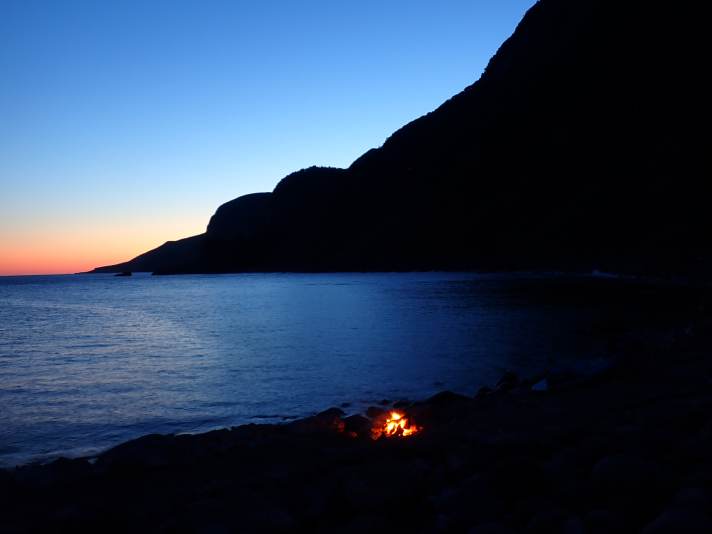
Did you often spend the night on the beach? Or did you benefit from the hospitality of the locals?
During my earlier journeys, I often had supporters with whom I could stay overnight. In the meantime, I don't really need that anymore and have therefore paid less attention to such contacts - so I have almost always spent the night in a tent. You also have to realise that windsurfing is very popular in some regions of Japan, but in most parts of the country it doesn't play a role at all.
What was your overall experience of the people in Japan? Open-minded? Or rather reserved?
People always think that the whole of Japan is full of high-tech industry. This is true in certain urban centres, but the majority of Japan is quite rural, without tourism, there is fishing but not much else going on. The culture is not such that you are not immediately surrounded by people when you get your surf equipment out of the water as a European. Everyone lets you do what you want, but it's rather friendly and distant. Nobody tells you: "You can't do that!". But nobody usually says anything either (laughs). I also had a different rhythm. By the time I launched my gear in the harbour in the morning, the locals had already been out at sea fishing for a few hours.
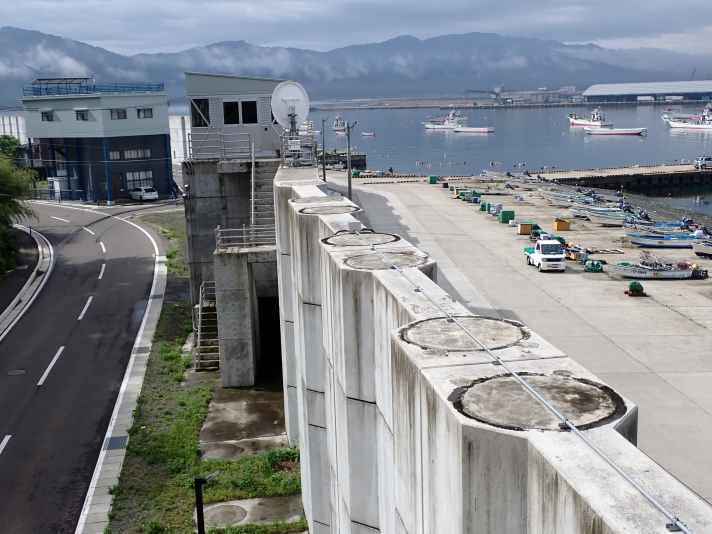
You always had the problem in the back of your mind that you are not allowed to stay in Japan indefinitely. How were you able to solve your visa problem?
As a tourist you are allowed to stay for 90 days. If you go to an immigration office before it expires, you can have it extended for another 90 days. This six-month period took me all the way round the North Island and back to the island of Honshu. It expired last November and I had to leave the country for a few days. Fortunately, I had already met my friend Yumiko and we travelled to South Korea for a few days.
How do you find love - somewhere in Japan - as a swashbuckling, neoprene-scented sea dog?
That was of course a great coincidence. I had just arrived at the northern end of the island of Honshu and was waiting for favourable weather to cross over to Hokkaido. There was an onsen (Japanese hot spring, the ed.) there. I was freshly showered, shaved and combed and didn't look nearly as dishevelled as usual (laughs). I saw her reading a book in a launderette, but didn't speak to her. She did a day later when I bumped into her again on the street. We went out for a meal and a day later I surfed to Hokkaido. But of course we stayed in touch and a few days later, on a weekend with terrible weather, she travelled after me - and accompanied me for a few weeks. That was worth its weight in gold, of course, because I suddenly had company and support on land. It took the pressure off me of always having to stop at certain places.
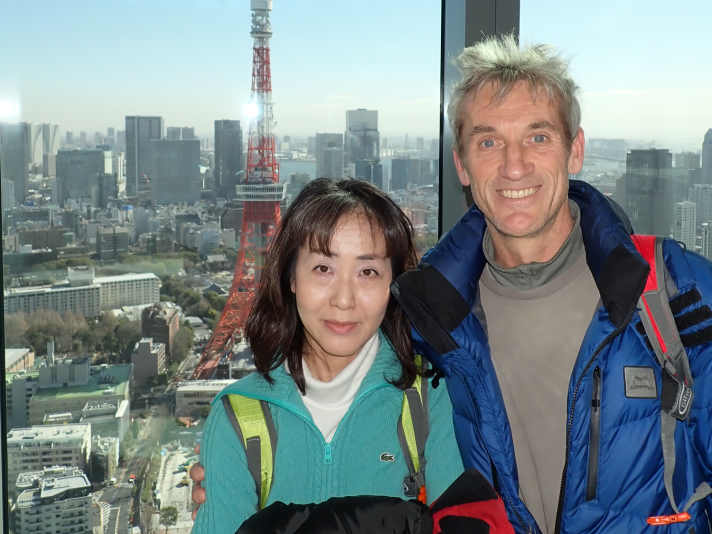
You had to interrupt your trip for a few weeks in the meantime. Why?
As I said, I set off a little late and when a gust threw my beautiful sail onto a fence and destroyed it, I first had to organise a replacement. After that, at the latest, it was clear that I wouldn't be able to complete the route along the north-west coast before winter set in. I had expected the north-west coast in the Sea of Japan to be much more relaxed than the Pacific coast. That was a complete misconception!
Why?
The wind blows from Siberia across the Sea of Japan and comes onshore. The wind then builds up and it rains or snows. What's more, the wind is blocked by the steep shore, which means you hardly have any wind, but you have constant swells, sea mist and drizzle. Marvellous. I had long hoped to catch a window of good weather to get a few hundred kilometres south and thus into warmer climes, but unfortunately this didn't materialise. We used the winter weeks to renovate Yumiko's flat, and in March my journey could finally continue. Yumiko had to start working again and I was more on my own. But the further south I travelled, the more pleasant it became - warmer weather, moderate winds and, along the island of Kyushu, some stretches with offshore islands that blocked the waves.
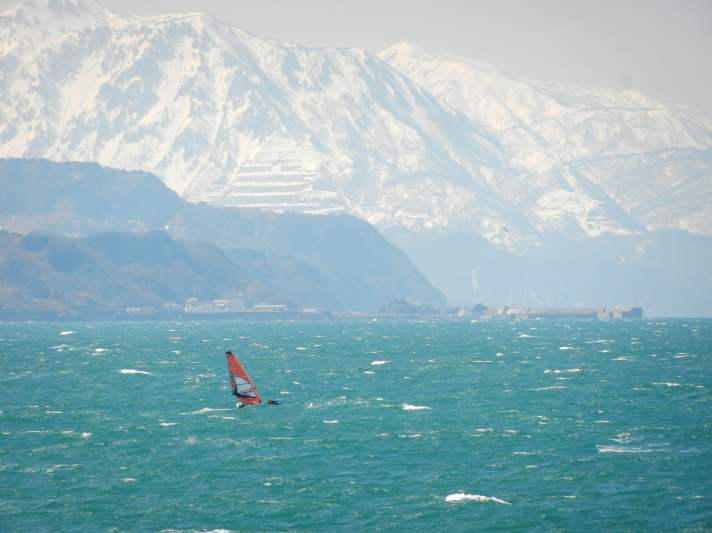
So the south was a piece of cake compared to the harsh north?
The pleasant phase only lasted a while, then the rainy season began. That meant: often calm, always hot and humid and usually rain or fog. But if you're prepared to paddle two kilometres on your knees, you'll always make progress somehow (laughs).
You covered a total of around 7,500 kilometres. Did your equipment last until the end?
As I mentioned, I had to replace the sail once in the winter because it had landed on a fence. Apart from that, the equipment suffers, of course, and by the end I had already patched a few holes on the board and in the sail. A game changer for me was that I switched to a different fin. Even along the Pacific coast, I often had the problem of fishing nets blocking my way. These are often attached to the shore and reach out up to two kilometres. I therefore often had to surf far from the coast, where the current is very strong, and take long detours - until I switched to a special fin.
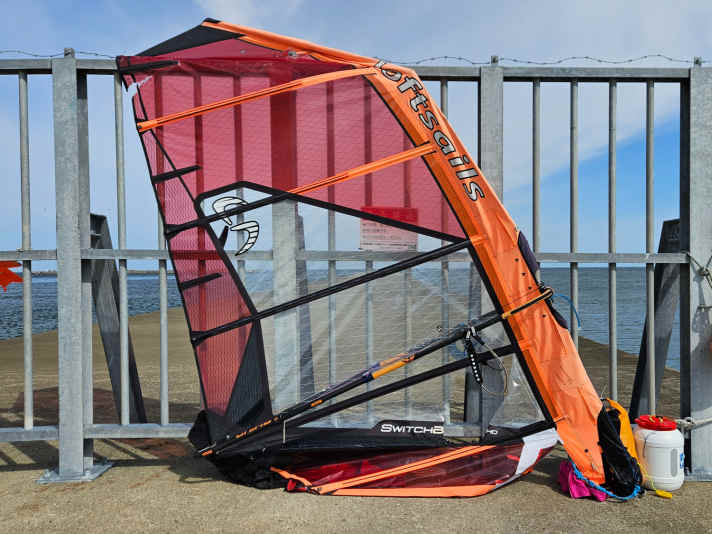
Was that a weed fin with more slope?
Yes, something like that. I enquired with Select Fins and they made me an extremely stable carbon fin and sent it to a contact in Japan. The part saved me a lot of detours because I was able to get over the nets with it.
On your trip around Europe, you repeatedly discussed the pollution of the beaches and the environment as a whole. What was your impression of this in Japan?
Unfortunately, we have to realise that our oceans are not in a good state anywhere in the world. Wherever people don't clean up the beaches, things look bad. It's the same in Japan and around the Mediterranean. There is a lot of plastic waste, much of it from the fishing industry. When you arrive in the big harbours, there are mountains of old nets, baskets and other containers. It's apparently so cheap to produce the stuff that it's not economical to recycle the old stuff.
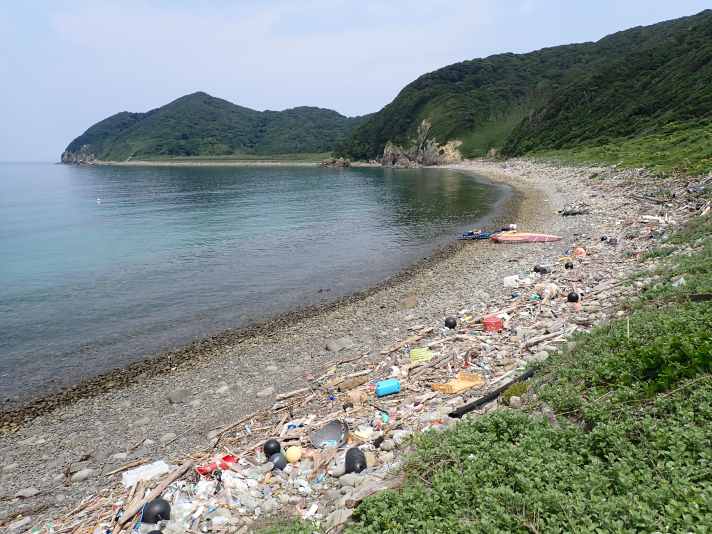
Your journey also took you past Fukushima, where there was a nuclear disaster after the tsunami in 2011...
I thought a lot beforehand about whether I would be able to just surf past there. Surprisingly, it was no problem at all to get there. I landed directly at the nearby Daiichi harbour. People aren't used to visitors there and it wasn't long before the police were on the scene. But in the end it wasn't a problem, because it's not forbidden to land here. Some people still live there and there are even a few fishing boats still moored in the huge harbour area. But the surroundings look spooky, as the whole landscape has been buried under a layer of earth and sand to cover the radioactively contaminated layers.
You've surfed around the UK and Europe, now around Japan. What's next?
I already have something to do to make the transition to a normal everyday life easier. I want to write a book about the trip. Not to make money - more to close this chapter for me. Yumiko is here and we enjoy our time together - if I don't end up in prison (laughs). But I think sooner or later I want to go travelling again. The coast of South America all the way down to Patagonia, that would be amazing.

